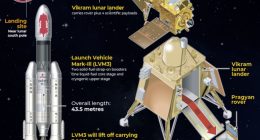Utilising data from observatories, a team of astronomers have modelled emission lines to demonstrate how supermassive clouds can influence star formation in interstellar clouds. They have used observations from the Atacama Large Millimeter Array (ALMA) and Very Large Telescope (VLT) of the European Southern Observatory (ESO) to measure the gas pressure in interstellar clouds impacted by jets and ambient clouds. The researchers have noted that the jets resulted in a change in the internal and external pressure of the molecular clouds that came their way.
Supermassive black holes are said to be located at the centre of most galaxies in our universe. Particles that fall into these black holes get trapped in the magnetic field and end up getting ejected outwards in the form of powerful jets of plasma.
These plasma jets are aligned perpendicular to the galactic disks. But, in a galaxy named IC 5063, which is located 156 million light-years away, the jets tend to be propagating within the disk where they interact with the cold and dense molecular gas clouds. This interaction is said to have the potential for compressing the jet-impacted clouds which in turn leads to gravitational instability and then star formation due to gas condensation.
In the study, published in Nature Astronomy, astronomers used the emissions of carbon monoxide (CO) and formyl cation (HCO+) sourced from ALMA and the emission of ionized sulphur and ionized nitrogen taken from VLT. Following this, the teams utilised some innovative and advanced astrochemical algorithms to highlight the environmental conditions in the outflow and in the surrounding medium.
The environmental conditions hold information on the strength of the far-ultraviolet radiation of stars, the rate at which gas is ionised by relativistic charged particles, and the mechanical energy left by jest on the gas. “We have performed many thousands of astrochemical simulations to cover a wide range of possibilities that may exist in IC 5063,” said co-author of the study Dr Thomas Bisbas, DFG Fellow of the University of Cologne.
According to lead author Professor Kalliopi Dasyra of the National and Kapodistrian University of Athens, the results show that supermassive black holes, even though they are located at the centres of galaxies, could affect star formation in a galaxy-wide manner.”







